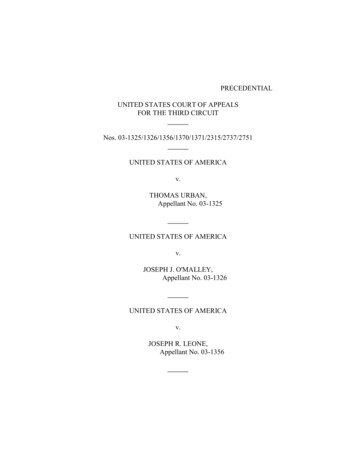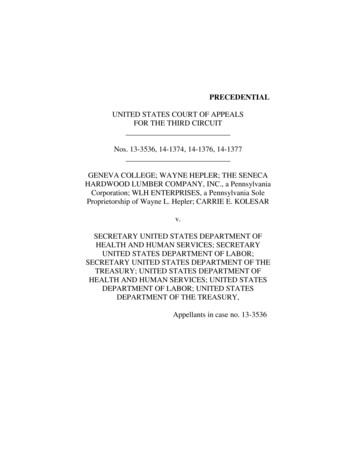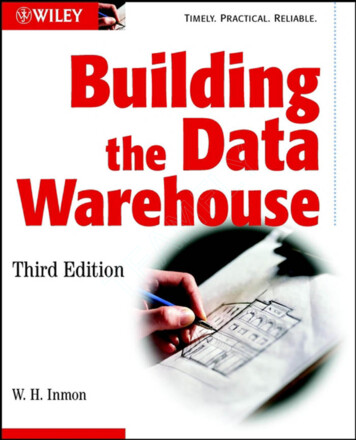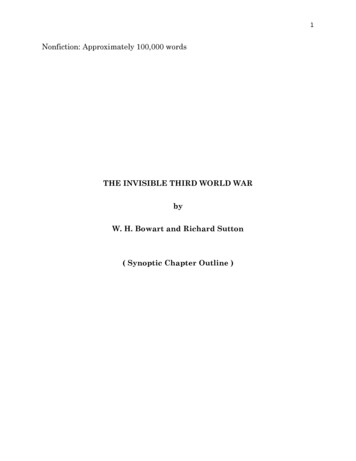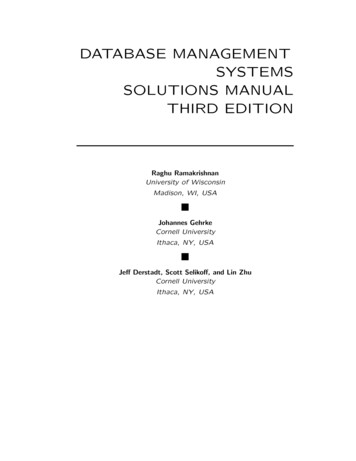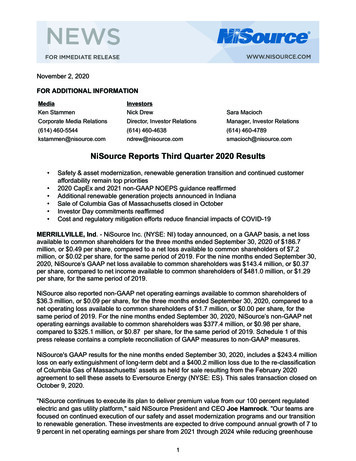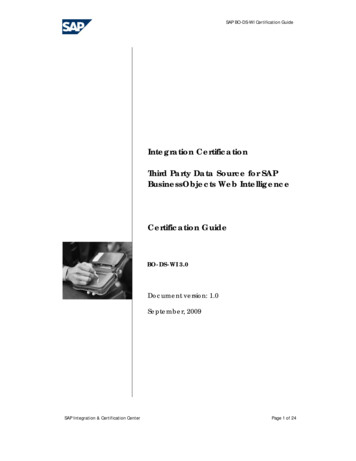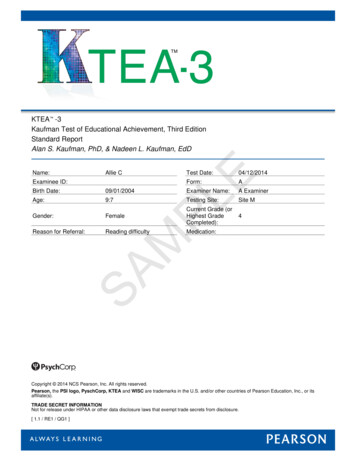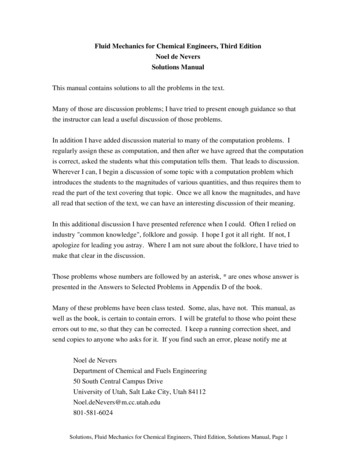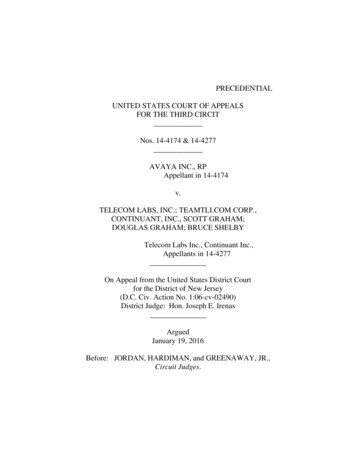
Transcription
PRECEDENTIALUNITED STATES COURT OF APPEALSFOR THE THIRD CIRCITNos. 14-4174 & 14-4277AVAYA INC., RPAppellant in 14-4174v.TELECOM LABS, INC.; TEAMTLI.COM CORP.,CONTINUANT, INC., SCOTT GRAHAM;DOUGLAS GRAHAM; BRUCE SHELBYTelecom Labs Inc., Continuant Inc.,Appellants in 14-4277On Appeal from the United States District Courtfor the District of New Jersey(D.C. Civ. Action No. 1:06-cv-02490)District Judge: Hon. Joseph E. IrenasArguedJanuary 19, 2016Before: JORDAN, HARDIMAN, and GREENAWAY, JR.,Circuit Judges.
(Filed: September 30, 2016)Seth P. Waxman [ARGUED]Leon B. GreenfieldDanielle M. SpinelliCatherine M.A. CarrollDavid L. SluisJonathan A. BresslerThomas G. SpranklingWilmer Cutler Pickering Hale and Dorr LLP1875 Pennsylvania Avenue, NWWashington, DC 20006Robert T. EganMark J. OberstaedtArcher & Greiner P.C.One Centennial Square33 E. Euclid AvenueHaddonfield, NJ 08033Jacob A. KramerBryan Cave LLP1155 F Street, NWWashington, DC 20004Lawrence G. ScarboroughBryan Cave LLPTwo North Central Avenue – Ste. 2200Phoenix, AZ 85004Counsel for Appellant/Cross-Appellee2
Douglas F. BroderK&L Gates LLP599 Lexington AvenueNew York, NY 10022Raymond A. CardozoPaul D. FogelReed Smith LLP101 Second Street – Ste. 1800San Francisco, CA 94105Kathy D. HelmerScott G. KobilAnthony P. LaRoccoJohn MarmoraCharles F. RysavyK&L Gates LLPOne Newark Center – 10th Fl.Newark, NJ 07102Richard L. Heppner, Jr.James C. Martin [ARGUED]Colin E. WrableyReed Smith LLP225 Fifth Avenue – Ste. 1200Pittsburgh, PA 15222Counsel for Appellees/Cross-AppellantsOPINION OF THE COURT3
Table of ContentsI.Introduction . 6II.Background . 8A.Factual Background . 81.PBX Systems and Maintenance . 92.PDS Systems and Maintenance . 143.The Dispute between Avaya and TLI . 15B.Procedural Background . 19III. Avaya’s Appeals. 24Judgment as a Matter of Law on Avaya’sA.Common Law Claims . 241.Evidence Supporting Avaya’s CommonLaw Claims. 262.Customer Contract Interpretation . 363.Tortious Interference with ProspectiveBusiness Advantage . 444.Unfair Competition. 545.Fraud . 576.Breach of Contract. 617.Conclusion . 67B.Prejudice on the Antitrust Verdict . 681.General Prejudice to Avaya’s Antitrust Defense . 682.“Fear, Uncertainty, and Doubt” Letters . 743.Interference with Defense and Cross-4
Examination. 764.C.Harmless Error Analysis . 78Antitrust Issues . 801.Tying in Antitrust Law . 802.PBX Attempted Monopolization Claim . 963.PDS Tying Claim . 102IV. TLI’s Cross-Appeals . 109A.Summary Judgment on TLI’s Common LawClaims . 109B.Summary Judgment on PBX Upgrade TyingClaim . 113C.V.Noerr-Pennington Ruling . 115Conclusion . 1185
JORDAN, Circuit Judge.I.IntroductionWhen asked why he was so intent on scaling MountEverest, the ill-fated mountaineer George Mallory famouslyreplied: “because it’s there.”1 The parties before us have puta twist on that philosophy: they have created their ownmountain of issues and have argued, appealed, and crossappealed nearly all of them.2 Unfortunately, if there had beena hope of bringing this matter to conclusion any time soon,that was dashed when, in the middle of trial, the DistrictCourt erroneously granted judgment as a matter of lawagainst one side, tainting the entire trial and the ultimateverdict. We will therefore vacate the judgment of the DistrictCourt and remand with instructions for further proceedings.We do not take this step lightly, but the error of the DistrictCourt here was of such magnitude that we seriously doubt thecorrectness of the ultimate verdict.This case arises from the fractured relationshipbetween a large communications equipment manufacturer,1Climbing Mount Everest Is Work for Supermen, N.Y.Times, Mar. 18, 1923, at 11.2The District Court recognized the battle-every-issuecharacter of the litigation. To one request from counsel to“make a record” of his objection, the Court responded: “Makea record, go ahead. The circuit will love it. It will be the5,927th error you have pointed out to them.” (J.A. 2397.)6
Avaya Inc. (“Avaya”), and one of its dealers and serviceproviders, TLI.3 After they fell out, Avaya aggressively actedto block TLI from providing independent maintenanceservices for Avaya equipment.Meanwhile, the nowindependent TLI took a series of legally dubious actions togain access to Avaya communications systems used by clientsthe parties once shared. Avaya filed suit, alleging severalbusiness torts and breach of contract; TLI counter-sued forantitrust violations. After years of pre-trial litigation, and inthe midst of a months-long trial, the District Court grantedTLI’s motion under Federal Rule of Civil Procedure 50 forjudgment as a matter of law against Avaya on all of Avaya’saffirmative claims. The Court later instructed the jury thatnone of TLI’s actions could be considered unlawful. Withthat instruction guiding it, the jury found Avaya liable for twoantitrust violations and awarded substantial damages.We conclude that the entry of judgment as a matter oflaw was erroneous. Given how intertwined the two sides’claims are – and given that Avaya’s antitrust defense relied inlarge part on justifying Avaya’s conduct as a response toTLI’s conduct – we also conclude that the erroneous Rule 50We use “TLI” as shorthand for a group of smallservice providers that are under common ownership andcontrol and are collectively the appellees/cross-appellants.They include Telecom Labs, Inc. (“TLI”), TeamTLI.comCorp., and Continuant, Inc., along with their common ownersand managers Douglas Graham, Scott Graham, and BruceShelby. Although Continuant seemingly took over thebusinesses’ continuing interests beginning in 2005, TLI wasthe firm most involved in this dispute from the beginning, sowe use that name for simplicity.37
judgment infected the jury’s verdict. We must thereforevacate the judgment of the District Court. A tour of themountain follows.II.BackgroundA.Factual BackgroundAvaya, the appellant and cross-appellee, “designs,manufactures, sells, and maintains telecommunicationsequipment.” (Opening Br. at 7.) Two of its products inparticular are the subject of this suit. The first is its privatebranch exchange (“PBX”), which “is essentially a specialpurpose computer . that functions as a telephoneswitchboard” and is used by “[l]arge organizations needing aninternal telephone network.” (Id.) The second product is itspredictive dialing system (“PDS”), which is an “automatedtelephone dialing system that uses a predictive algorithm toanticipate when the user . will be able to reach someone,improving the chances a call will be answered.” (Id. at 7-8.)The PBX technology was invented in the 1980s by AT&TCo., which in 1996 spun its PBX business off to LucentTechnologies, Inc., which in turn spun off Avaya in 2000.TLI and three individuals who operated it are theappellees and cross-appellants. TLI sold post-warrantymaintenance for Avaya PBXs and PDSs. At one point, TLIwas also part of Avaya’s Business Partner program, sellingcommunications systems on Avaya’s behalf. When Avayabegan downsizing from 1999 to 2001, it encouraged itsBusiness Partners to hire laid-off Avaya maintenancetechnicians, even subsidizing that process. TLI made severalsuch hires and began to offer maintenance services in 2001.8
Not long after, in 2003, TLI and Avaya acrimoniouslysevered their relationship,4 but TLI continued to providemaintenance services on Avaya products as an independentservice provider.1.PBX Systems and MaintenanceOf the two types of systems at issue in this litigation,the PBX has a substantially larger market.Avayacharacterizes PBX systems as durable goods with extendedlongevity and high fixed costs. During much of the timerelevant to this suit, PBX systems had a useful lifespan ofabout eight years, though some could remain in use fordecades.5 They have many capabilities but were sold in a4The reasons for the divorce are, of course, likeeverything else in this case, hotly contested, and they areelaborated in more detail below. Here is a thumbnail sketch:Avaya contends that TLI violated its obligations as an Avayaagent, whereas TLI alleges that Avaya imposed oneroussurprise conditions to prevent a partner firm like TLI fromrecouping the investments it had made at Avaya’s request.5Those statistics are based on PBXs sold before 2000.In the 2000s, traditional PBXs were replaced with systemsthat use internet protocol telephony. Whereas with older“refrigerator-box-type PBXs, it was . easy to identify anddefine what a . life of a system was,” with the “IP PBXs .any one server might come out of service, perhaps as quicklyas after just a couple . years.” (J.A. 4382.) Given theconstant replacement of equipment on those modern PBXs, itis “very difficult to measure” what the lifetime of a system is.(Id.)9
default mode without most of them activated. Customerscould then license individual capabilities, depending on theirneeds. As one Avaya systems engineer explained it at trial,Avaya “provide[s] software to our customers that’s able to doa vast number of things, but customers don’t want to pay forall the things the software can do. . They may not need allthe capabilities . . So we allow customers to purchase theright to use aspects of the software . .” (J.A. 1886.)One of those “aspects” is a set of maintenancefeatures6 that was and is licensed separately from the PBXsystem itself. Those features are accessed via on-demandmaintenance commands (“ODMCs”).Users of themaintenance features – whether Avaya technicians, nonAvaya technicians, or customers themselves – access thepertinent software using login credentials. Each login ismatched to the ODMCs that that specific user is authorized touse. In addition to controlling those logins, Avaya has asecond way to regulate access to the ODMCs. The ODMCsare only useable on a given PBX system if Avaya hasactivated the corresponding maintenance softwarepermissions (“MSPs”). Avaya’s PBX systems come with theMSPs disabled, but customers who execute a specific licenseagreement can have the MSPs, and hence the ODMCs,The use of the word “feature” to describe elements ofthe software that enabled remote maintenance is legallyrelevant to questions of contract interpretation in this case.See infra Part II.A.2. We use the word here as a generic term,without implying anything about how it should be read in thespecific context of Avaya’s contracts with its customers.610
enabled. Later, when that license terminates, Avaya disablesthe MSPs.Avaya and its authorized Business Partners offermaintenance service, which is a profitable line of business.Avaya contends that the “margin on the initial sale of a PBXis ‘thin,’” whereas the rate of profit on maintenance work ismuch higher. (Opening Br. at 8.) It says that the profit thecompany earns from maintenance is an important source offunds for the improvement of PBX systems and thedevelopment of new models, which are released roughlyevery two years. According to Avaya, its major competitorsin this market – Cisco, Siemens, and Microsoft – follow asimilar business model of low-margin equipment and highmargin maintenance, and those firms compete with each otherand with Avaya over the “total cost of ownership” of bothequipment and maintenance. (Opening Br. at 9.)During the time period covered by this litigation,Avaya offered three tiers of maintenance options for PBXcustomers. The highest-end, most expensive option was tobuy maintenance from Avaya itself, whose technicians hadfull access to ODMCs and certain other Avaya softwarecapabilities.The second, intermediate, option was to purchasemaintenance from an authorized Avaya Business Partner.Business Partners could access a customer’s maintenancesoftware through a login called “DADMIN,” once Avayaactivated it on a customer’s PBX. As participants in Avaya’smaintenance program, Business Partners had to completespecial training and were given access to engineering support.They also had to agree not to solicit maintenance contracts11
from existing Avaya maintenance customers.Avayaforthrightly admits that it thus imposed vertical restraints onmaintenance through the Business Partner program toencourage the Business Partners to “expand sales of AvayaPBXs in the competitive primary market, rather than simplyto cannibalize existing maintenance business.” (Opening Br.at 13.)Finally, Avaya offered a self-maintenance option to itscustomers. Prior to 2008, customers who undertook tomaintain their own PBX systems would have to purchase alicense to gain access to the necessary MSPs. In 2005, out oftens of thousands of Avaya PBX customers, about 270 ofAvaya’s largest customers used the self-maintenance option,which allowed their in-house technology departments toperform maintenance on their PBX systems. With its 2008hardware release, Avaya began making MSPs part of the basepackage for all PBX purchasers, so that they no longer had topay additional money for access to those maintenancefeatures. They were, however, then subject to heightenedcontractual restrictions against using independent serviceproviders (“ISPs”).7ISPs in fact became a fourth source of maintenance forAvaya PBX systems, and – from Avaya’s perspective at least– a very unwelcome one. Avaya has made no secret of its7The Avaya expert who testified about the change inpolicy suggested that the reason for the change was that thefeatures available for purchase on the PBXs had become sonumerous that Avaya began including many of them bydefault.12
hostility to ISPs, and it acknowledges that it “has never giventhird parties the logins necessary to access the ODMCsneeded to maintain PBXs.” (Opening Br. at 15.) As Avayacharacterizes it, prior to 2003, there were no significant ISPson the market, and they did not become noticeable marketplayers until 2005. At that point, Avaya released an internalJuly 2005 bulletin affirming that “Avaya . does not providemaintenance support for clients of or directly to unauthorizedservice providers” (J.A. 7043), and it recapitulated its policythat MSPs and self-maintenance licensing would not beavailable to customers who used ISPs. A 2006 federal courtopinion rejected an antitrust suit challenging Avaya’s policyagainst giving ISPs maintenance software access.8In its campaign against ISPs, Avaya updated itscustomer agreements in 2008 to make explicit that PBXpurchasers agreed not to use unauthorized third parties for8See United Asset Coverage, Inc. v. Avaya Inc., 409 F.Supp. 2d 1008, 1046 (N.D. Ill. 2006). That court’s analysiswas critical of the kind of monopolization and tying claimsnow brought by TLI. Because “the software built intoAvaya’s PBXs to facilitate their maintenance and repair isproprietary,” the court rejected the argument that maintenanceand hardware were separate antitrust markets. Id. at 1045-46.It also rejected the claim that Avaya had surprised itscustomers with a post-sale policy change, characterizing thatmonopolization claim as “border[ing] on the absurd” because“[n]o one has an unclouded crystal ball as to future events,nor does anyone have a vested right in the expectation that thefuture will remain the same as the present.” Id. at 1046.13
any service that required MSPs. Specifically, one licenserestriction stated that theCustomer agrees not to . allow any serviceprovider or other third party, with the exceptionof Avaya’s . resellers and their designatedemployees . to use or execute any softwarecommands that cause the software to performfunctions that facilitate the maintenance orrepair of any Product except . those softwarecommands that . would operate if . [MSPs]were not enabled or activated.(J.A. 7283.)2.PDS Systems and Maintenance9The other Avaya equipment at issue in this case is thePDS system, the market for which is substantially smallerthan the PBX market. Avaya presented evidence at trial thatno more than 840 Avaya PDS systems were installednationwide (about 20% of the total PDS market), with Avayaproviding maintenance service to about 200 of thosecustomers.10 PDS systems tend to induce less long-termThe phrase “PDS system” is redundant (because the“S” in PDS is “system”), but we use it for its colloquial ease,as the District Court did.910Because of the relatively small size of the PDSmaintenance market, none of Avaya’s Business Partners hasbecome a PDS maintenance provider.14
intra-brand reliance than PBXs because the cost of an entirelynew PDS is similar to the cost of upgrading an existingsystem.The PDS market is similar to the PBX market in atleast one important respect. In both, Avaya says, the profitsfrom maintenance contracts help fund the development ofnew systems and the upgrades of existing systems. Avayaregularly updates its PDS software with patches to “fix bugsor adapt the product to changing circumstances.” (OpeningBr. at 14.) Prior to 2007, patches were available for free toPDS customers on Avaya’s website; after 2007, customerswho purchased new PDS systems could only receive patchesif they purchased a minimum of one year of software supportfrom Avaya.3.The Dispute between Avaya and TLIThe two sides in this case present dramaticallydifferent stories of their dispute, which began in 2003.11Avaya’s story is that it simply enforced long-standing policiesagainst a disloyal former contractor that was breachingcontractual duties and dishonestly undermining Avaya’srelationships with its customers. TLI’s version is that Avayaretroactively sprung an anticompetitive policy on itscustomers that prevented them from using ISPs, in order to11Most issues before us are raised by Avaya, againstwhom the District Court entered judgment as a matter of lawand against which a verdict was rendered. Nonetheless, bothsides have appealed a variety of issues, and we endeavor torecount the facts neutrally.15
vindictively force out of business a competitor who couldprovide better maintenance service at a lower cost.From 1996 to 2003, TLI was an Avaya BusinessPartner and sold Avaya systems. Around 2000, Avayalaunched a program to encourage Business Partners to offermaintenance services. TLI took the opportunity.12 It claimsit “invested millions in building its maintenance capabilities,”while continuing to loyally sell Avaya PBX systems –reaching roughly five million dollars in sales in 2002.(Answering Br. at 5.)The relationship between Avaya and TLI soured thatsame year, over TLI’s efforts to compete for maintenancecontracts with other Business Partners and with Avayadirectly. Avaya had introduced a revised set of obligationsfor its Business Partners, the new program being set forth inwhat Avaya called the “Avaya One” agreement. The intentwas to limit intra-brand co
predictive dialing system (“PDS”), which is an “automated telephone dialing system that uses a predictive algorithm to anticipate when the user . will be able to reach someone, improving the chances a call will be answered.” (Id. at 7-8.)
